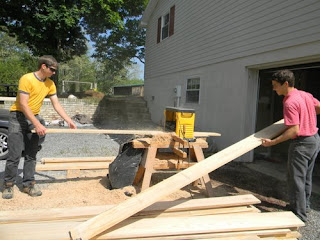While opinions vary on what constitutes a good diet, everyone agrees on the benefit of freshly grown food. Whether you grow it yourself, or pick it up at a farmer's market, the quality of food right off the plant is unbeatable.
Nothing says spring time to me then asparagus. It is also one of those vegetables that benefits from being freshly picked. If you've only had frozen or canned asparagus, you haven't yet eaten asparagus.
I know everyone doesn't like asparagus. I'll warn you, at our house, you don't say you don't like something, you just have not yet learned to like it. I tell the children to eat a bite or two at every meal, and they will soon like it. So far, three children have proved me right on asparagus and the two year old doesn't yet count. (And yes, I fully admit that my personal food dislikes are because I never learned to like them. And I never intend to give squid, sushi, or coffee a fair chance!)
Asparagus is one of the cheapest easiest vegetables to grow. Six years ago we bought 25 plants for $10.50. The first two years we harvested very little as we waited for the plants to become established. Since then we have had about a six week harvest each spring. In colder weather I pick every other day. In warmer weather, I pick every day. Each picking is one or two pounds.
I don't know exactly how much we pick but VERY conservatively, I'd say that we pick 30 lb a year. The market near us sells asparagus at $4.00 a pound. So at the very least, we are picking $120.00 worth of asparagus a year. After the initial investment of plants, we have had no further expense. Asparagus is a perennial and can produce for many many years. See why I call it one of the cheapest vegetables to grow?
 The labor spent to grow asparagus is also minimal. Harvesting asparagus is as simple as cutting it off close to the ground, trimming off any tough ends and preparing to eat. Sometime in June, the asparagus stalks become thinner. When they are only as thick as a pencil, I quit picking and allow the stalks to grow into huge ferny plants that are rather pretty. We keep the plants mulched to avoid weeding throughout the summer.
The labor spent to grow asparagus is also minimal. Harvesting asparagus is as simple as cutting it off close to the ground, trimming off any tough ends and preparing to eat. Sometime in June, the asparagus stalks become thinner. When they are only as thick as a pencil, I quit picking and allow the stalks to grow into huge ferny plants that are rather pretty. We keep the plants mulched to avoid weeding throughout the summer.In the fall, I cut down all the stalks, add manure or compost to the bed and cover with a thick layer of mulch, either grass clippings or leaves. Nothing else needs done until the warm spring air awakens the plants to push out new stalks.
The only pest I've had to deal with is the asparagus beetle which lays tiny black eggs along the stalk. If I see the beetle on the stalks, I squash them. Otherwise, I wash off the eggs and they don't really do much damage. I do remove the stalks far from the bed in the fall in hopes to keep any overwintering beetles away from the patch.
Eat

Hands down, our favorite way to eat asparagus is Stacked Asparagus.
Other favorites
Skillet Asparagus

Sausage Asparagus Skillet

Great Green Vegetable Pasta
Crustless Quiche with Ham and Asparagus
Asparagus is also known to show up on pizza, in a wrap and on a salad at our house. We like asparagus. Need I say more?
I don't like frozen asparagus, preferring to eat it several times a week when in season, then turning to other vegetables the rest of the year. I do freeze a couple bags for a pot of asparagus soup in the winter. My sister-in-law just shared a yummy version with me. When I try her recipe, I'll share it with you.
Now it is your turn...
How do you do like asparagus?
Any other growing tips?













































